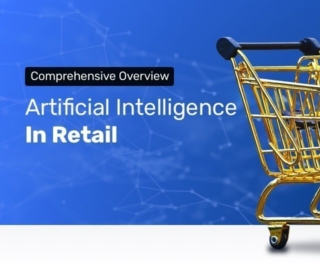
After a presentation at the Shop!Association’s national conference late last year, I had plenty of time to chat with retail business people about their own ideas about AI’s uses, and the trends that matter most. This prompted me to gather my thoughts and combine the ideas of retailers with the AI-in-retail research we’ve done, and put together a piece to help retail vendors make sense of the next 2-3 years of AI’s influence in retail.
AI’s customer service applications are expected to grow drastically in the coming years. According to technology research firm Gartner, Gartner predicts that by 2020, AI will be a top five investment priority for more than 30 percent of CIOs, in and out of retail.
In this article, we showcase AI developments in retail to help companies carefully plan about AI adoption in the future. Our discussion is presented in the following sections:
- Forward-looking trends of AI in retail that will likely be implement in the next five years
- Issues in AI that limit retailers’ adoption of such technology in their businesses
- Steps companies should take to avoid falling into the massive AI hype
The Future of Retail – AI and the “Instrumented Environment”
(Below is the full slide deck used at my presentation for the Shop!Association annual conference. This article is intended to be a short summary of the major points covered in this presentation.)
Artificial Intelligence in Restaurants and Food Services from Daniel Faggella
AI companies develop devices that provide data used in business decisions. One of the trends that we believe will be robust in the near future is camera technology that helps create “instrumented” environments in stores. These devices allow store owners to observe customer behavior using sensing technologies such as VideoMining’s camera and software.
The company mounts cameras in a store’s ceiling to record buyers’ behavior. The shoppers’ paths are then transformed into data points by its software and then combined with other data sources such as point of sale, shopper intercepts, online surveys and loyalty card data. The numbers are then used to provide actionable analytics report.
Here’s an overview of how the company claims it can help improve in-store purchases.
We believe that large retailers will implement AI technology of this kind in the next five years. They will follow the business model of online retailers where buyer analytics is highly monitored brought about by their capacity to invest and hire top AI experts to carry out tech projects.
These companies’ in-store marketing must involve facial recognition to correlate products with satisfaction, measurement of repeat visits and customization of layouts. Small stores, on the other hand, may not be able to adopt AI at the same rate due to financial and human resource constraints.
From my conversations with retailers at the Shop!Association annual conference, the idea of “instrumented” or “alive” environments was a major point of interest. More and more, physical space will shift to add the benefits of digital space, namely: Testing variations and positions, tracking behavior and purchases, and using that data to inform future tests and decisions.
Here’s a collection of ideas from my conversations with retail vendors, highlighting some of the ideas that they’re contemplating as retail evolves:
- Lighting companies may be able to encourage visits to certain isles, or views to certain products, by adjusting slowly. This might be used to guide customers to new products, or to steer them towards high-margin items to help reach the store’s profit goals.
- Companies producing physical displays may want to develop more features for varying the displays appearance, or making it easier to move. As testing layouts becomes a viable and ongoing aspect of retail, displays that allow for more testing options may serve the customer need better (even while involving no AI themselves).
- As an ecosystem of “retail AI” consulting groups firms (already somewhat underway at large firms like GenPact and Accenture) will allow retail vendors a new consulting channel for selling into big retailers, by building relatinships with the consulting firms who help retail leaders make purchasing decisions.
In terms of robotics, only a few cater to retail applications and most of them are not promising except for SImbe Robotics’ Tally that audits store shelves to provide inventory analytics.
The robot monitors shelves and tallies out-of-stock items and those that need replenishment. It is also said to be capable of detecting pricing errors. We believe that the robot’s value in instrumented retail environments will be profitable in the future when such trends will transform the retail experience.
Avoid “Toy” AI Applications
Companies using AI in their operations and sales may fall into adopting AI for purposes other than solving a business problem. These AI developments are called “toy” applications to describe their worthless nature that’s only good for press release. Having a toy application would only waste the company’s resources since it can never guarantee ROI.
Another issue is the huge investment in talent and development of AI applications. Companies need to also set up a management structure that will look into using the AI to solve their operational issues by doing intensive research on its development. Furthermore, top talent is very scarce and expensive, more so for AI consultants. As such, large companies for now have the capability of using AI.
AI adoption should therefore be carefully planned and researched. Company leaders should know when to consider it important to implement in their business rather than releasing an AI application for its own sake without the right management in place.
Filtering the Retail AI Hype
Industry market intelligence firm Retail Systems Research stated in its article that AI is starting to fall prey to the “silver bullet syndrome” – or the assumption that the next change in technology will be a panacea to a company’s problems, the single “make or break” factor for the future of the industry. The article also states (and I agree), that companies may fall into such syndrome if they are desperate to match the efforts of Amazon.
Indeed this skepticism is warranted. From our own research, it seems clear that the anticipation of AI is stronger than it’s influence on day-to-day retail operations. The firms most likely to use AI in the retail sector are not going to be retail vendors or small-to-medium sized vendors.
Instead, we predict that the first uses will be from retail giants like Target, BestBuy, and other behemoths with massive transaction volumes, and the budgets that can afford to experiment with technology, and hire expensive AI talent. Today, only Amazon stands out for it’s actual use of AI in retail, and even then, it’s mostly for their online (not offline) applications. We may be 2-4 years away from the initial breakthroughs that make AI become a staple in retail, and we may be yet another 4 years before these technologies become viable or useful for smaller retail players.
With the overwhelming news about AI reportedly being able to provide cost savings to Company A or increasing sales figures by twofold for Company B, we observe that 90 percent of press releases exaggerate its impact. In most every sector we study (including our study on the impact of machine learning in marketing, where we analyzed over 500 companies), under 15% of so-called “AI startups” have:
- A meaningful pilot applications to help prove their impact, and
- The requisite AI talent on their teams to actual build something useful.
Retail is no exception.
We recommend that enterprises be more discerning about the AI news and use cases they read. They should stay alert on what large retail players are investing in AI and if these have already made ROI.
Small companies should look into in-store strategies to keep with the trends while retail giants for now are applying AI technology in their operations. These developments will trickle down to small companies in the next five years and will likely spur improvements in the way small businesses sell their products.
Concluding Thoughts
Business leaders should resist adopting AI brought about by the hype that it is getting in press. They should look at what in AI is realistically possible and relevant in their field by identifying what in their business can be solved by AI and how it can relate to its overall goals. It will also help to consult with companies currently implementing similar AI applications to get a better take on such decisions.
There is no need, at least for now, for most retail vendor companies to integrate AI in their own products. Rather, smaller retail players should be following the developments of Amazon and other retail giants – and possibly brainstorming about how their products and offerings will make their way into an increasingly track-able, quantifiable retail environment in the decade ahead.
Article based on a presentation by Dan Faggella – initial transcription and editing by Edgar Alan Rayo.
Header image credit: Shop!Association







